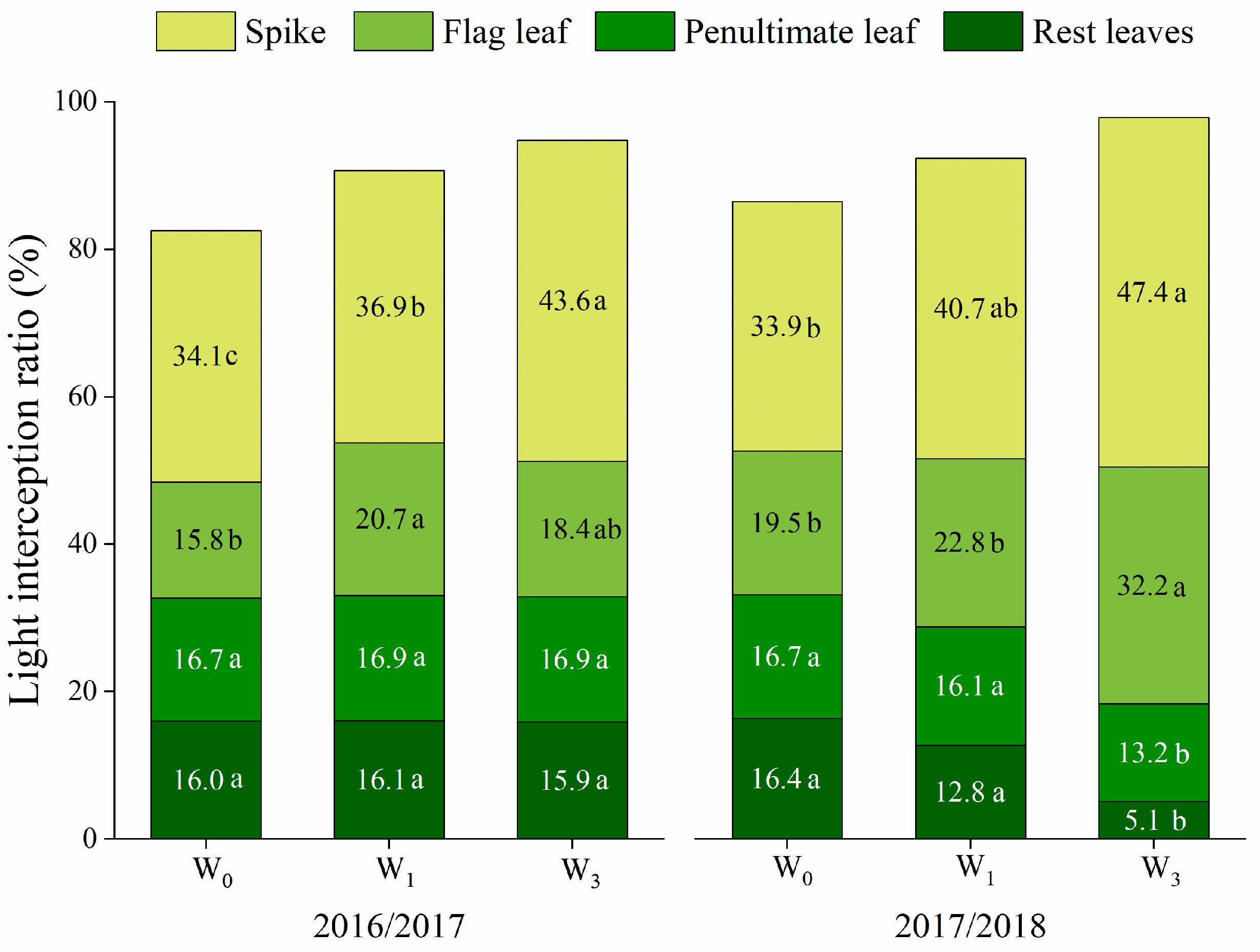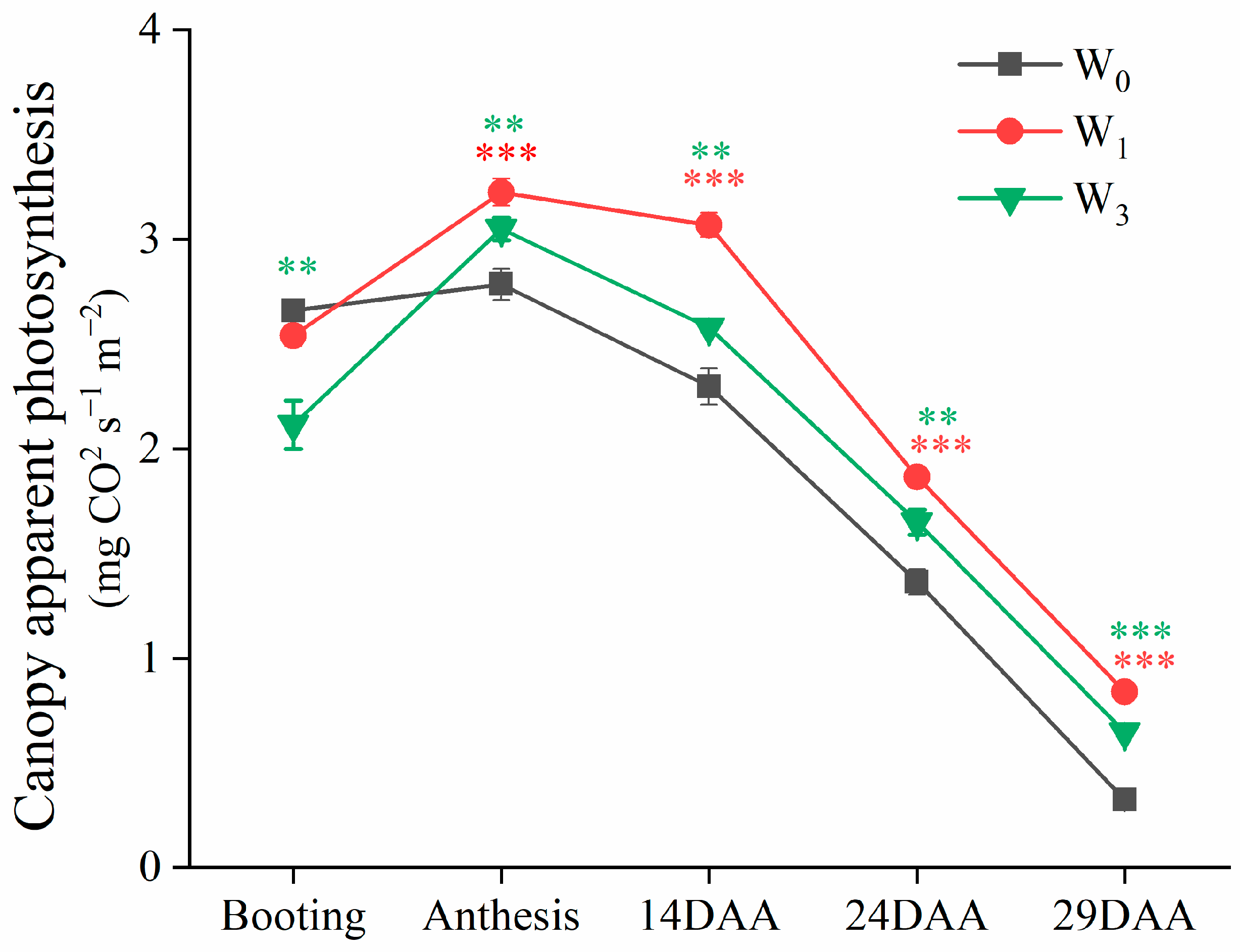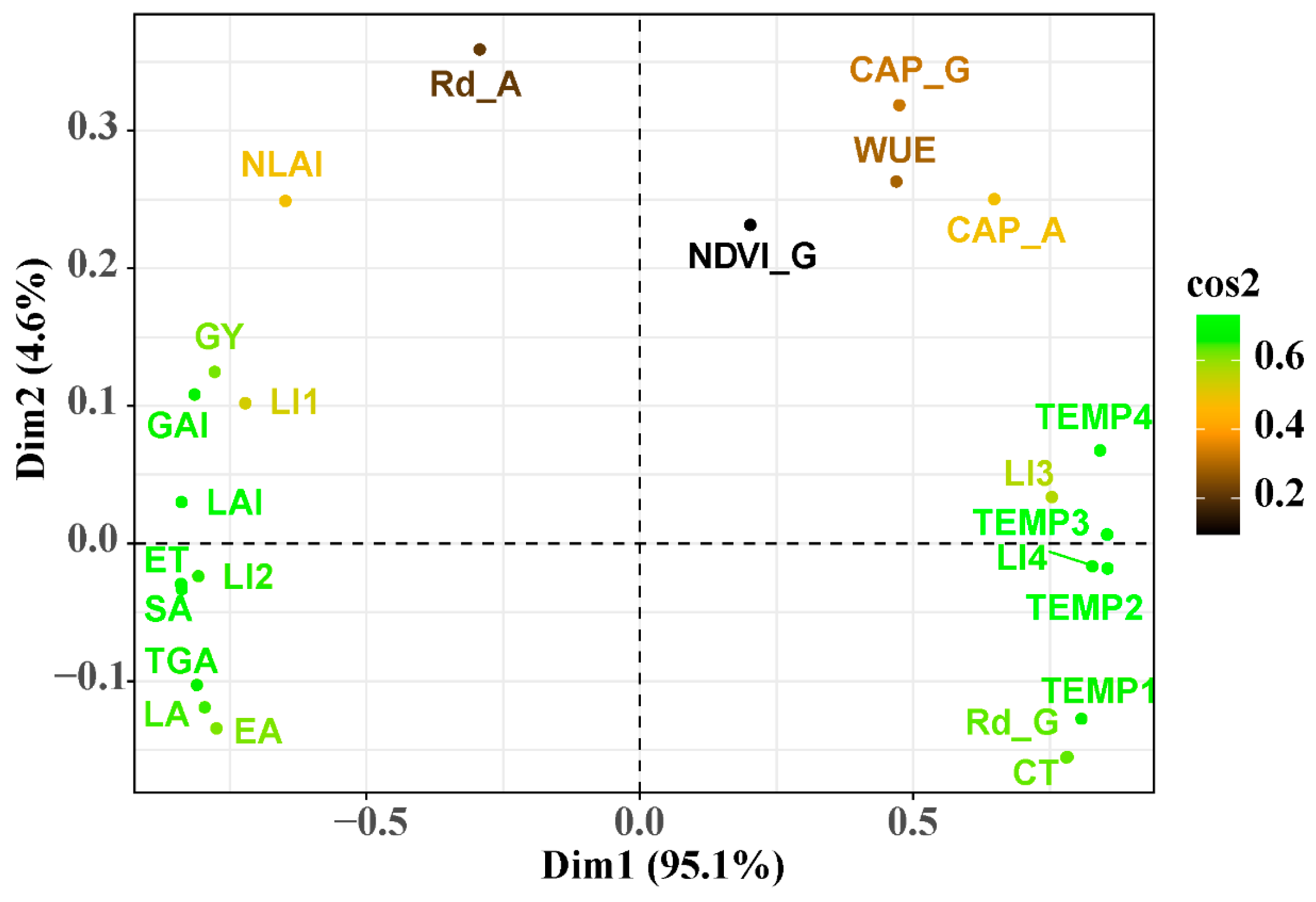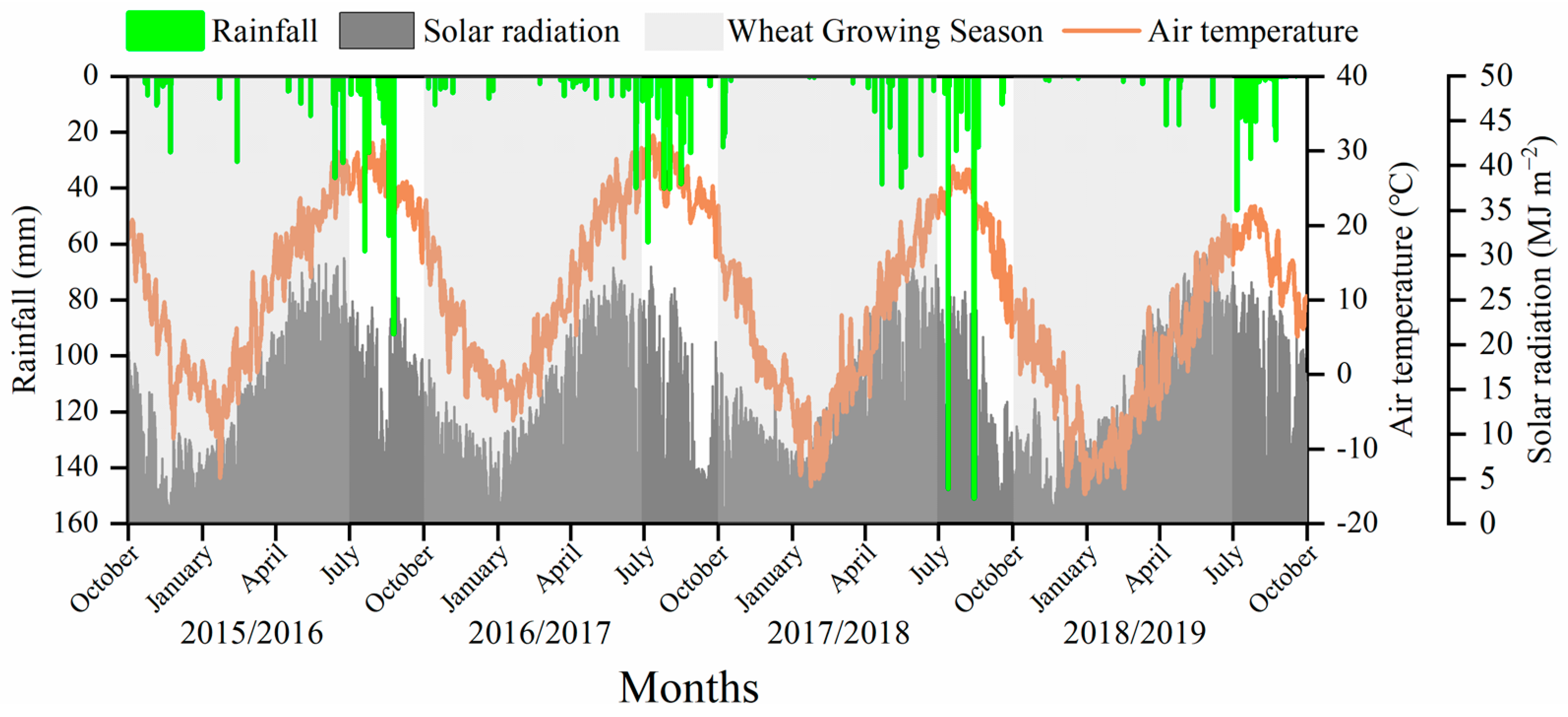Canopy Structure, Light Intensity, Temperature and Photosynthetic Performance of Winter Wheat under Different Irrigation Conditions
Abstract
:1. Introduction
2. Results
2.1. Soil Water Content
2.2. Canopy Architecture
2.2.1. The Area and Ratio of the Photosynthetic Organs
2.2.2. Canopy Green Organs’ Area Index
2.2.3. Light Interception
2.3. Temperature of Canopy and Organs
2.3.1. Canopy Temperature and Canopy Temperature Depression
2.3.2. Temperature of Organs
2.4. Canopy Photosynthetic Rate and Respiration Rate
2.4.1. Canopy Apparent Photosynthesis at Different Growth Stages
2.4.2. Diurnal Variation of Canopy Apparent Photosynthesis and Respiration Rate
2.5. Normalized Difference Vegetation Index
2.6. Yield, ET and WUE
2.7. Correlation Analysis
3. Discussion
4. Materials and Methods
4.1. Experimental Site and Experimental Design
4.2. Measurements
4.2.1. Green Organ Areas
4.2.2. Light Interception
4.2.3. The Canopy Temperature and Temperature of Wheat Organs
4.2.4. The Normalized Difference Vegetation Index
4.2.5. Canopy Apparent Photosynthesis
4.2.6. Grain Yield, Soil Water Content, Evapotranspiration (ET), and WUE
4.3. Statistical Analysis
5. Conclusions
Author Contributions
Funding
Data Availability Statement
Conflicts of Interest
References
- Shewry, P.R. Wheat. J. Exp. Bot. 2009, 60, 1537–1553. [Google Scholar] [CrossRef]
- Erenstein, O.; Jaleta, M.; Mottaleb, K.A.; Sonder, K.; Donovan, J.; Braun, H. Global trends in wheat production, consumption and trade. In Wheat Improvement: Food Security in a Changing Climate; Springer International Publishing: Cham, Switzerland, 2022; pp. 47–66. [Google Scholar]
- Niinemets, Ü. A review of light interception in plant stands from leaf to canopy in different plant functional types and in species with varying shade tolerance. Ecol. Res. 2010, 25, 693–714. [Google Scholar] [CrossRef]
- Luo, C.; Guo, Z.; Xiao, J.; Dong, K.; Dong, Y. Effects of Applied Ratio of Nitrogen on the Light Environment in the Canopy and Growth, Development and Yield of Wheat When Intercropped. Front. Plant Sci. 2021, 12, 719850. [Google Scholar] [CrossRef] [PubMed]
- Ma, S.; Wang, T.; Guan, X.; Zhang, X. Effect of sowing time and seeding rate on yield components and water use efficiency of winter wheat by regulating the growth redundancy and physiological traits of root and shoot. Field Crop. Res. 2018, 221, 166–174. [Google Scholar] [CrossRef]
- Zeng, R.; Lin, X.; Welch, S.M.; Yang, S.; Huang, N.; Sassenrath, G.F.; Yao, F. Impact of water deficit and irrigation management on winter wheat yield in China. Agric. Water Manag. 2023, 287, 108431. [Google Scholar] [CrossRef]
- Oweis, T.; Hachum, A. Optimizing supplemental irrigation: Tradeoffs between profitability and sustainability. Agric. Water Manag. 2009, 96, 511–516. [Google Scholar] [CrossRef]
- Wang, D.; Yu, Z.; White, P.J. The effect of supplemental irrigation after jointing on leaf senescence and grain filling in wheat. Field Crop. Res. 2013, 151, 35–44. [Google Scholar] [CrossRef]
- You, Y.; Song, P.; Yang, X.; Zheng, Y.; Dong, L.; Chen, J. Optimizing irrigation for winter wheat to maximize yield and maintain high-efficient water use in a semi-arid environment. Agric. Water Manag. 2022, 273, 107901. [Google Scholar] [CrossRef]
- Zhao, Z.; Qin, X.; Zang, H.; Chen, C.; Zhang, Y.; Wang, Z. Value of groundwater used for producing extra grain in North China Plain. Field Crop. Res. 2017, 210, 47–51. [Google Scholar] [CrossRef]
- Bhusal, N.; Lee, M.; Reum Han, A.; Han, A.; Kim, H.S. Responses to drought stress in Prunus sargentii and Larix kaempferi seedlings using morphological and physiological parameters. For. Ecol. Manag. 2020, 465, 118099. [Google Scholar] [CrossRef]
- Gao, Y.; Zhang, M.; Yao, C.; Liu, Y.; Wang, Z.; Zhang, Y. Increasing seeding density under limited irrigation improves crop yield and water productivity of winter wheat by constructing a reasonable population architecture. Agric. Water Manag. 2021, 253, 106951. [Google Scholar] [CrossRef]
- Sadras, V.O.; Villalobos, F.J.; Fereres, E.; Wolfe, D.W. Leaf responses to soil water deficits: Comparative sensitivity of leaf expansion rate and leaf conductance in field-grown sunflower (Helianthus annuus L.). Plant Soil. 1993, 153, 189–194. [Google Scholar] [CrossRef]
- Wang, H.; Zhang, L.; Dawes, W.R.; Liu, C. Improving water use efficiency of irrigated crops in the North China Plain—Measurements and modelling. Agric. Water Manag. 2001, 48, 151–167. [Google Scholar] [CrossRef]
- Xu, X.; Zhang, M.; Li, J.; Liu, Z.; Zhao, Z.; Zhang, Y.; Zhou, S.; Wang, Z. Improving water use efficiency and grain yield of winter wheat by optimizing irrigations in the North China Plain. Field Crop. Res. 2018, 221, 219–227. [Google Scholar] [CrossRef]
- He, L.; Li, H.; He, J.; Han, D.; Li, R.; Wang, H. Irrigation at appearance of top 2nd or flag leaf could improve canopy photosynthesis by regulating light distribution and LAI at each leaf layer. Field Crop. Res. 2023, 295, 108883. [Google Scholar] [CrossRef]
- Zhang, M.; Gao, Y.; Zhang, Y.; Fischer, T.; Zhao, Z.; Zhou, X.; Wang, Z.; Wang, E. The contribution of spike photosynthesis to wheat yield needs to be considered in process-based crop models. Field Crop. Res. 2020, 257, 107931. [Google Scholar] [CrossRef]
- Zhang, Y.; Zhang, Y.; Wang, Z.; Wang, Z. Characteristics of canopy structure and contributions of non-leaf organs to yield in winter wheat under different irrigated conditions. Field Crop. Res. 2011, 123, 187–195. [Google Scholar] [CrossRef]
- Li, Q.; Dong, B.; Qiao, Y.; Liu, M.; Zhang, J. Root growth, available soil water, and water-use efficiency of winter wheat under different irrigation regimes applied at different growth stages in North China. Agric. Water Manag. 2010, 97, 1676–1682. [Google Scholar] [CrossRef]
- Kaya-Altop, E.; Şahin, M.; Jabran, K.; Phillippo, C.J.; Zandstra, B.H.; Mennan, H. Effect of different water management strategies on competitive ability of semi-dwarf rice cultivars with Echinochloa oryzoides. Crop Prot. 2019, 116, 33–42. [Google Scholar] [CrossRef]
- Zhao, W.; Liu, L.; Shen, Q.; Yang, J.; Han, X.; Tian, F.; Wu, J. Effects of Water Stress on Photosynthesis, Yield, and Water Use Efficiency in Winter Wheat. Water 2020, 12, 2127. [Google Scholar] [CrossRef]
- Shang, Y.; Lin, X.; Li, P.; Gu, S.; Lei, K.; Wang, S.; Hu, X.; Zhao, P.; Wang, D. Effects of supplemental irrigation at the jointing stage on population dynamics, grain yield, and water-use efficiency of two different spike-type wheat cultivars. PLoS ONE 2020, 15, e230484. [Google Scholar] [CrossRef] [PubMed]
- Shang, Y.; Wang, S.; Lin, X.; Gu, S.; Wang, D. Supplemental irrigation at jointing improves spike formation of wheat tillers by regulating sugar distribution in ear and stem. Agric. Water Manag. 2023, 279, 108160. [Google Scholar] [CrossRef]
- Richards, R.A.; Cavanagh, C.R.; Riffkin, P. Selection for erect canopy architecture can increase yield and biomass of spring wheat. Field Crop. Res. 2019, 244, 107649. [Google Scholar] [CrossRef]
- Bhusal, N.; Park, I.H.; Jeong, S.; Choi, B.; Han, S.; Yoon, T. Photosynthetic traits and plant hydraulic dynamics in Gamhong apple cultivar under drought, waterlogging, and stress recovery periods. Sci. Hortic. 2023, 321, 112276. [Google Scholar] [CrossRef]
- Thapa, S.; Jessup, K.E.; Pradhan, G.P.; Rudd, J.C.; Liu, S.; Mahan, J.R.; Devkota, R.N.; Baker, J.A.; Xue, Q. Canopy temperature depression at grain filling correlates to winter wheat yield in the U.S. Southern High Plains. Field Crop. Res. 2018, 217, 11–19. [Google Scholar] [CrossRef]
- Fukai, S.; Mitchell, J. Role of canopy temperature depression in rice. Crop Environ. 2022, 1, 198–213. [Google Scholar] [CrossRef]
- Rashid, A.; Stark, J.C.; Tanveer, A.; Mustafa, T. Use of canopy temperature measurements as a screening tool for drought tolerance in spring wheat. J. Agron. Crop Sci. 1999, 182, 231–238. [Google Scholar] [CrossRef]
- Royo, C.; Villegas, D.; Del Moral, L.G.; Elhani, S.; Aparicio, N.; Rharrabti, Y.; Araus, J.L. Comparative performance of carbon isotope discrimination and canopy temperature depression as predictors of genotype differences in durum wheat yield in Spain. Aust. J. Agric. Res. 2002, 53, 561–569. [Google Scholar] [CrossRef]
- Pinto, R.S.; Reynolds, M.P. Common genetic basis for canopy temperature depression under heat and drought stress associated with optimized root distribution in bread wheat. Theor. Appl. Genet. 2015, 128, 575–585. [Google Scholar] [CrossRef]
- Reynolds, M.; Manes, Y.; Izanloo, A.; Langridge, P. Phenotyping approaches for physiological breeding and gene discovery in wheat. Ann. Appl. Biol. 2009, 155, 309–320. [Google Scholar] [CrossRef]
- Rebetzke, G.J.; Jimenez-Berni, J.A.; Bovill, W.D.; Deery, D.M.; James, R.A. High-throughput phenotyping technologies allow accurate selection of stay-green. J. Exp. Bot. 2016, 67, 4919–4924. [Google Scholar] [CrossRef] [PubMed]
- Tan, C.; Zhang, P.; Zhou, X.; Wang, Z.; Xu, Z.; Mao, W.; Li, W.; Huo, Z.; Guo, W.; Yun, F. Quantitative monitoring of leaf area index in wheat of different plant types by integrating NDVI and Beer-Lambert law. Sci. Rep. 2020, 10, 929. [Google Scholar] [CrossRef] [PubMed]
- Thapa, S.; Rudd, J.C.; Xue, Q.; Bhandari, M.; Reddy, S.K.; Jessup, K.E.; Liu, S.; Devkota, R.N.; Baker, J.; Baker, S. Use of NDVI for characterizing winter wheat response to water stress in a semi-arid environment. J. Crop Improv. 2019, 33, 633–648. [Google Scholar] [CrossRef]
- Sun, H.; Liu, C.; Zhang, X.; Shen, Y.; Zhang, Y. Effects of irrigation on water balance, yield and WUE of winter wheat in the North China Plain. Agric. Water Manag. 2006, 85, 211–218. [Google Scholar] [CrossRef]
- Zhao, H.; Zhang, P.; Wang, Y.; Ning, T.; Xu, C.; Wang, P. Canopy morphological changes and water use efficiency in winter wheat under different irrigation treatments. J. Integr. Agric. 2020, 19, 1105–1116. [Google Scholar] [CrossRef]
- Dandan, Z.; Jiayin, S.; Kun, L.; Quanru, L.; Quanqi, L. Effects of irrigation and wide-precision planting on water use, radiation interception, and grain yield of winter wheat in the North China Plain. Agric. Water Manag. 2013, 118, 87–92. [Google Scholar] [CrossRef]
- Nguyen, T.H.; Langensiepen, M.; Gaiser, T.; Webber, H.; Ahrends, H.; Hueging, H.; Ewert, F. Responses of winter wheat and maize to varying soil moisture: From leaf to canopy. Agric. For. Meteorol. 2022, 314, 108803. [Google Scholar] [CrossRef]
- Xu, C.; Tao, H.; Tian, B.; Gao, Y.; Ren, J.; Wang, P. Limited-irrigation improves water use efficiency and soil reservoir capacity through regulating root and canopy growth of winter wheat. Field Crop. Res. 2016, 196, 268–275. [Google Scholar] [CrossRef]
- Bhusal, N.; Han, S.; Yoon, T. Summer pruning and reflective film enhance fruit quality in excessively tall spindle apple trees. Hortic. Environ. Biotechnol. 2017, 58, 560–567. [Google Scholar] [CrossRef]
- Feng, G.; Luo, H.; Zhang, Y.; Gou, L.; Yao, Y.; Lin, Y.; Zhang, W. Relationship between plant canopy characteristics and photosynthetic productivity in diverse cultivars of cotton (Gossypium hirsutum L.). Crop J. 2016, 4, 499–508. [Google Scholar] [CrossRef]
- Ayeneh, A.; van Ginkel, M.; Reynolds, M.P.; Ammar, K. Comparison of leaf, spike, peduncle and canopy temperature depression in wheat under heat stress. Field Crop. Res. 2002, 79, 173–184. [Google Scholar] [CrossRef]
- Panozzo, J.F.; Eagles, H.A.; Cawood, R.J.; Wootton, M. Wheat spike temperatures in relation to varying environmental conditions. Aust. J. Agric. Res. 1999, 50, 997–1006. [Google Scholar] [CrossRef]
- Graß, R.; Böttcher, U.; Lilienthal, H.; Wilde, P.; Kage, H. Is canopy temperature suitable for high throughput field phenotyping of drought resistance of winter rye in temperate climate? Eur. J. Agron. 2020, 120, 126104. [Google Scholar] [CrossRef]
- Zhao, G.; Mu, Y.; Wang, Y.; Wang, L. Response of winter-wheat grain yield and water-use efficiency to irrigation with activated water on Guanzhong Plain in China. Irrig. Sci. 2021, 39, 263–276. [Google Scholar] [CrossRef]
- IBM SPSS Software. Available online: https://www.ibm.com/spss (accessed on 6 September 2023).
- OriginLab—Origin and OriginPro—Data Analysis and Graphing Software. Available online: https://www.originlab.com (accessed on 6 September 2023).
- R: The R Project for Statistical Computing. Available online: https://www.R-project.org (accessed on 6 September 2023).
- Industry-Leading Vector Graphics Software Adobe Illustrator. Available online: https://www.adobe.com/products/illustrator.html (accessed on 6 September 2023).







| Year | Irrigation Times | Leaf Area and Ratio (cm2, %) | Stem Area and Ratio (cm2, %) | Spike Area and Ratio (cm2, %) | Total Area (cm2) |
|---|---|---|---|---|---|
| 2015/2016 | W0 | 46.2 ± 0.5 b(48.7) | 38.4 ± 1.1 a(40.4) | 10.4 ± 0.1 b(10.9) | 95.0 ± 1.5 b |
| W1 | 56.6 ± 3.5 a(50.4) | 43.9 ± 1.7 a(39.2) | 11.6 ± 0.3 a(10.4) | 112.1 ± 5.5 a | |
| W3 | - | - | - | - | |
| 2016/2017 | W0 | 33.5 ± 1.3 b(40.2) | 39.3 ± 0.8 b(47.3) | 10.4 ± 0.2 b(12.5) | 83.3 ± 1.4 b |
| W1 | 45.5 ± 1.9 a(45.2) | 44.0 ± 1.1 a(44.0) | 10.8 ± 0.4 ab(10.8) | 100.3 ± 2.9 a | |
| W3 | 49.1 ± 0.7 a(49.2) | 39.1 ± 1.0 b(39.1) | 11.8 ± 0.4 a(11.8) | 100.0 ± 1.1 a | |
| 2017/2018 | W0 | 37.7 ± 1.5 b(52.2) | 24.8 ± 0.5 c(34.3) | 9.7 ± 0.2 b(13.4) | 72.1 ± 2.0 b |
| W1 | 38.4 ± 3.2 b(51.1) | 26.8 ± 0.7 b(35.9) | 9.7 ± 0.2 b(13.0) | 74.8 ± 3.9 b | |
| W3 | 61.5 ± 3.0 a(58.1) | 32.6 ± 0.7 a(30.8) | 11.8 ± 0.3 a(11.2) | 105.9 ± 3.9 a | |
| 2018/2019 | W0 | 45.7 ± 2.9 b(51.0) | 34.7 ± 1.6 b(38.8) | 9.2 ± 0.3 b(10.3) | 89.6 ± 4.4 b |
| W1 | 53.6 ± 7.5 b(50.4) | 41.5 ± 4.0 b(39.4) | 10.6 ± 0.2 a(10.2) | 105.7 ± 11.6 b | |
| W3 | 77.3 ± 7.0 a(54.0) | 54.1 ± 3.5 a(37.9) | 11.4 ± 0.5 a(8.1) | 142.8 ± 10.7 a |
| Year | Irrigation Times | LAI | NLAI | GAI |
|---|---|---|---|---|
| 2015/2016 | W0 | 3.83 ± 0.10 b | 4.05 ± 0.16 b | 7.88 ± 0.25 b |
| W1 | 5.30 ± 0.30 a | 5.20 ± 0.17 a | 10.50 ± 0.47 a | |
| W3 | - | - | - | |
| 2016/2017 | W0 | 2.74 ± 0.11 c | 4.06 ± 0.08 b | 6.80 ± 0.12 c |
| W1 | 3.98 ± 0.17 b | 4.80 ± 0.11 a | 8.78 ± 0.26 b | |
| W3 | 4.88 ± 0.06 a | 5.06 ± 0.13 a | 9.94 ± 0.11 a | |
| 2017/2018 | W0 | 3.28 ± 0.05 c | 3.01 ± 0.12 b | 6.29 ± 0.17 c |
| W1 | 4.22 ± 0.21 b | 4.02 ± 0.07 a | 8.24 ± 0.15 b | |
| W3 | 5.70 ± 0.27 a | 4.11 ± 0.08 a | 9.81 ± 0.33 a | |
| 2018/2019 | W0 | 3.70 ± 0.24 b | 3.55 ± 0.15 b | 7.25 ± 0.36 b |
| W1 | 4.42 ± 0.62 ab | 4.29 ± 0.34 ab | 8.72 ± 0.95 ab | |
| W3 | 5.39 ± 0.49 a | 4.57 ± 0.26 a | 9.96 ± 0.74 a |
| Year | Irrigation Times | CT (°C) | CTD (°C) | ||||
|---|---|---|---|---|---|---|---|
| 1 DAA | 10 DAA | 20 DAA | 1DAA | 10 DAA | 20 DAA | ||
| 2016/2017 | W0 | 25.17 a | 28.78 a | 33.17 a | 4.23 c | 4.02 d | 3.24 d |
| W1 | 24.95 b | 28.13 b | 32.76 b | 4.45 b | 4.67 c | 3.64 c | |
| W2 | - | 27.84 c | 32.32 c | - | 4.96 b | 4.08 b | |
| W3 | 24.68 c | 27.43 d | 32.07 d | 4.72 a | 5.37 a | 4.33 a | |
| 2017/2018 | W0 | 24.82 a | 19.56 a | 29.44 a | 3.88 c | 4.07 c | 3.56 c |
| W1 | 24.17 b | 19.12 b | 28.70 b | 4.53 b | 4.39 b | 4.30 b | |
| W2 | - | 18.27 c | 28.67 b | - | 4.61 b | 4.33 b | |
| W3 | 23.86 c | 17.73 d | 28.10 c | 4.84 a | 5.04 a | 4.90 a | |
| Time | Irrigation Times | Organ Temperature (°C) | |||
|---|---|---|---|---|---|
| Spike | Flag Leaf | Central of the Stem | Base of the Stem | ||
| 1 DAA | W0 | 26.35 a | 23.19 a | 22.64 a | 23.91 a |
| W1 | 25.43 b | 22.72 b | 22.29 b | 23.77 b | |
| W2 | - | - | - | - | |
| W3 | 24.83 c | 21.86 c | 21.41 c | 22.92 c | |
| 10 DAA | W0 | 20.63 a | 18.95 a | 18.91 a | 19.62 a |
| W1 | 19.54 b | 18.73 b | 18.48 b | 19.02 b | |
| W2 | 19.04 c | 18.19 c | 18.16 c | 18.85 b | |
| W3 | 18.51 d | 18.08 c | 17.96 d | 18.34 c | |
| 20 DAA | W0 | 30.92 a | 27.87 a | 28.77 a | 30.83 a |
| W1 | 28.91 b | 27.12 b | 28.14 b | 30.28 ab | |
| W2 | 28.33 c | 27.08 b | 27.91 b | 29.99 bc | |
| W3 | 28.38 d | 26.88 c | 27.69 b | 29.51 c | |
| Year | Irrigation Times | Yield (kg ha−1) | ET (mm) | WUE (kg m−3) |
|---|---|---|---|---|
| 2015/2016 | W0 | 6298 ± 63 c | 396.0 ± 13.1 c | 1.59 ± 0.02 b |
| W1 | 7702 ± 226 b | 444.9 ± 2.1 b | 1.73 ± 0.05 a | |
| W2 | 8500 ± 30 a | 482.2 ± 4.1 a | 1.76 ± 0.01 a | |
| W3 | - | - | - | |
| 2016/2017 | W0 | 6370 ± 101 c | 392.6 ± 12.7 c | 1.63 ± 0.05 b |
| W1 | 7084 ± 191 b | 404.3 ± 3.4 bc | 1.75 ± 0.01 ab | |
| W2 | 7736 ± 91 a | 430.1 ± 1.6 b | 1.80 ± 0.01 a | |
| W3 | 8059 ± 158 a | 464.0 ± 15.4 a | 1.74 ± 0.06 ab | |
| 2017/2018 | W0 | 6415 ± 198 c | 354.8 ± 9.3 c | 1.81 ± 0.06 bc |
| W1 | 7519 ± 104 b | 391.0 ± 13.7 b | 1.92 ± 0.03 ab | |
| W2 | 8135 ± 50 a | 417.2 ± 9.2 b | 1.95 ± 0.01 a | |
| W3 | 8291 ± 194 a | 488.1 ± 2.5 a | 1.70 ± 0.04 c | |
| 2018/2019 | W0 | 5446 ± 118 d | 334.2 ± 11.1 c | 1.63 ± 0.04 b |
| W1 | 6247 ± 105 c | 352.5 ± 9.0 c | 1.77 ± 0.03 a | |
| W2 | 7264 ± 89 b | 422.5 ± 2.7 b | 1.72 ± 0.02 ab | |
| W3 | 7883 ± 240 a | 469.8 ± 2.4 a | 1.68 ± 0.05 ab |
| Irrigation Treatment | Irrigation Amount (mm) | |||
|---|---|---|---|---|
| Before Sowing Stage | Tillering Stage | Jointing Stage | Anthesis Stage 2 | |
| W0 | 100 mm | - | - | - |
| W1 | 100 mm | - | 75 mm | - |
| W2 | 100 mm | - | 75 mm | 75 mm |
| W3 1 | 100 mm | 75 mm | 75 mm | 75 mm |
Disclaimer/Publisher’s Note: The statements, opinions and data contained in all publications are solely those of the individual author(s) and contributor(s) and not of MDPI and/or the editor(s). MDPI and/or the editor(s) disclaim responsibility for any injury to people or property resulting from any ideas, methods, instructions or products referred to in the content. |
© 2023 by the authors. Licensee MDPI, Basel, Switzerland. This article is an open access article distributed under the terms and conditions of the Creative Commons Attribution (CC BY) license (https://creativecommons.org/licenses/by/4.0/).
Share and Cite
Zhang, M.; Chen, W.; Jing, M.; Gao, Y.; Wang, Z. Canopy Structure, Light Intensity, Temperature and Photosynthetic Performance of Winter Wheat under Different Irrigation Conditions. Plants 2023, 12, 3482. https://doi.org/10.3390/plants12193482
Zhang M, Chen W, Jing M, Gao Y, Wang Z. Canopy Structure, Light Intensity, Temperature and Photosynthetic Performance of Winter Wheat under Different Irrigation Conditions. Plants. 2023; 12(19):3482. https://doi.org/10.3390/plants12193482
Chicago/Turabian StyleZhang, Meng, Weiwei Chen, Maoya Jing, Yanmei Gao, and Zhimin Wang. 2023. "Canopy Structure, Light Intensity, Temperature and Photosynthetic Performance of Winter Wheat under Different Irrigation Conditions" Plants 12, no. 19: 3482. https://doi.org/10.3390/plants12193482







